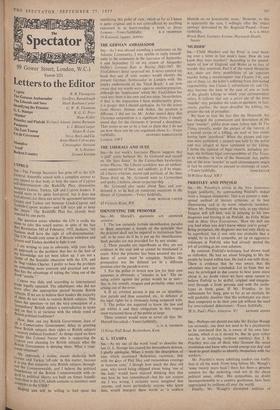'MURDER'
SIR,—'Child Murders and the Press' is your head- ing over a letter in last week's issue. How do you know they were murders? According to the amend- ments of law of England and Wales as to fact of murder that constitute Part I of the recent Homicide ACt, there are three possibilities of an apparent murder being a manslaughter (see Clauses 2-4), and one of these, i.e. the killer's suffering from dirnnisheld responsibility (see Clause 2, subsections (I) and (3)), may become. the issue in the case of one or both of the ghastly killings to which your correspondent refers. It follows that any a priori use of the term 'murder' may prejudice the cases in question; in fact, ceteris paribus, the more dreadful the killing, the greater the risk of prejudice. We have to face the fact that the Homicide Act has changed the connotation and denotation of the 'term 'murder'; public print must follow suit. In The Times, recently, under the picture of the funeral of a named victim of a killing, we read of this victim having been 'murdered.' When the picture and cap- ticin were published, a,suspect was held by the police and was alleged to have confessed to the killing. I invite the opinion of legal experts, including per- haps the brilliant legal correspondents of The Times, as to whether, in view of the Homicide Act, public use of .the term 'murder' in such circumstances might in fact he construed to amount to contempt of court.
































 Previous page
Previous page